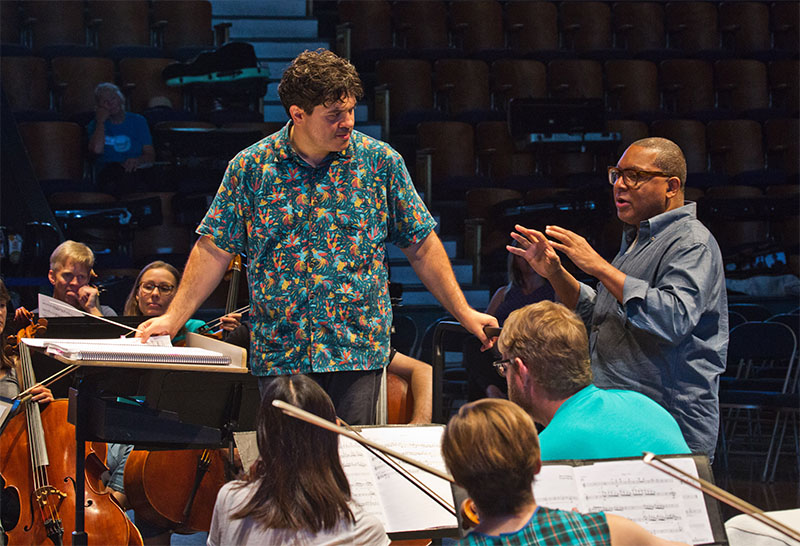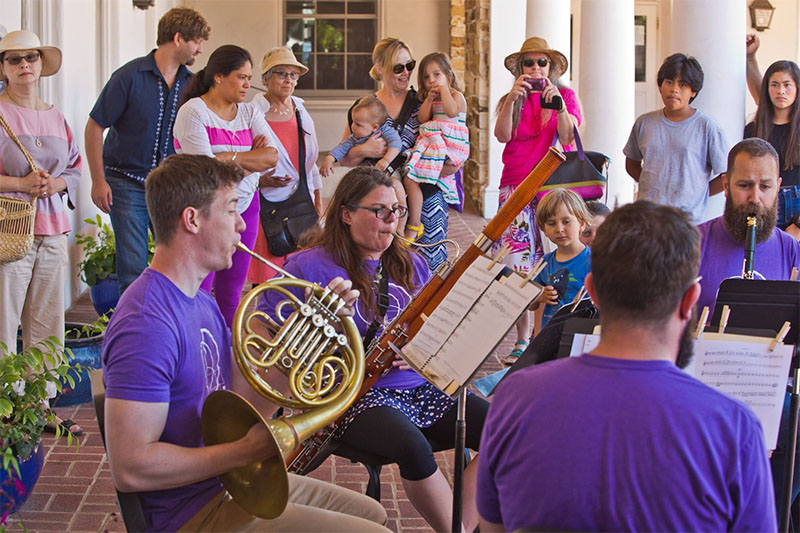
During the open rehearsal of Concerto in D for violin and orchestra (2015), which will be a part of tonight’s concert, Wynton, Wynton gave the orchestra many notes which approached technical specificities through larger ideas having to do with the emotions behind the work, as well as the communal experience of playing it. At one point, he asked orchestra members to feel the loneliness and the joy of the section they were rehearsing, so that their individual experiences of those feelings would give way to a “collective experience” in the music. He described the collective experience as “a realization of how we are all together.” In his book, Moving to Higher Ground: How Jazz Can Change Your Life (2009), Wynton discusses the collective experience of playing and listening to jazz. The jazz concert brings people into one space and encourages them to stay, while also “following musicians’ ideas and trying to hear the human depth of their sound,” which he describes as empathetic listening (67). Wynton’s concerto is largely about communion—the communion of music styles, of perspectives, and of people. In his program notes, he shares why: “We believe that all human beings are connected in the essential fundamentals of life: birth, death, love, and laughter; that our most profound individual experiences are also universal (especially pain); and acknowledging the depth of that pain in the context of a groove is a powerful first step towards healing.”
In the 21st century, we often become aware of the universality of our experience and feelings through artistic conversations happening online and in the media. When we find music that resonates with some aspect of our identities, it is often mediated in some way, be it YouTube, Spotify, or iTunes, and experienced in the isolated space of headphones, homes, or offices. This can be positive, in that it allows widespread access to these conversations, however, the experience of gathering with others and forming a temporary community centered around the act of listening is, to me, totally different. The intention that comes along with this act creates the feeling that what is happening in that performance space is important, and everybody who is in that space is important too. Wynton articulates this perfectly, saying: “Because jazz, when played by a group, means ‘Come together. Be together. Stay together’—at least for the duration of the song. And in music the duration of a tune represents a lifetime” (107).

Wynton’s comments here are specific to blues and jazz and the social history embedded in these styles—however, they’ve affected the way I’ve been reflecting on this Festival and Community Night in particular. This was the second year that Cabrillo has put on Community Night, and the event was both highly attended and well received. It followed two other community-oriented concerts: the Free Family Concert and the Community Sing with Roomful of Teeth, both of which strongly emphasized audience participation. These events offered opportunities for creating connectivity amongst concert-goers and between the audience and the performers. Community Night, while more like a traditional concert, was unique in that it featured individual performances and compositions from the orchestra members, and was a “pay what you can” event, thanks to the support of Santa Cruz County Bank and The Humanities Institute (THI) at UCSC. Due to the high involvement of THI in publicizing Community Night, there were more students than normal in the audience. There were also many families and new Festival attendees, making for a curious and energetic crowd. Craig and Emily Wong’s performances, both private and inviting, set the tone for a concert that one audience member described to me as “very personal.” Also contributing to the personal feeling of the concert were the performers’ introductions, which gave listeners insight into the musicians, their pieces, and the Festival. Many of them shared their love for the Festival community, and Cristi was sure to point out just how impactful it is for the musicians to be hosted by families in the area.
After the concert, all attendees had the opportunity to chat with the musicians. During this time, I sat down with a woman named Eileen, who I’d seen at many of the open rehearsals throughout the season. During our conversation, I got to learn a little bit about her life, her relationship with the Festival, and the Civic Auditorium. Just today I ran into someone downtown who had also attended the concert. When I asked him what his impressions of the concert were, he raved about Svet Stoyanov’s performance of Rhythmic Caprice. We also shared the opinion that Emily Wong’s piano composition was absolutely beautiful. It occurs to me that I wouldn’t have had the chance to meet him or Eileen had it not been for the Festival. In fact, through the Festival I’ve become familiar with many new and local names and faces. This has helped me feel more like a part of the Santa Cruz community, which can, I think, be difficult for students, who are so often spending most of their time in the space of the college or university. This can also be difficult for people who are unable to afford attending the significant events within a community, which is why I believe that events like Community Night, which make symphonic concerts more accessible, more personal, and more diverse, so valuable. They remind people that they are a part of a connected system, that they are sharing space with others every day, and that their presence in that space matters. Wynton describes the appeal of the jazz club in such a way that is useful for thinking about what kind of space the symphonic hall could be through more events like Community Night. He writes:
“With all the other, more accessible forms of entertainment available, why do people come here? Because once the band begins to play, they know that for the next hour and fifteen minutes, everyone—musicians and waitresses, the initiated and the unsuspecting—will be united in the purest possible expression of community, having made the choice to become “us” instead of “me.” Both musicians and audience are charged with the same set of difficult propositions: to listen to a point of view that’s not quite your own with the same level of interest with which you speak; to roll with the punches; to give at least as much as you take.” (80)
Tonight, concert-goers will have the exciting opportunity to experience the musical expression of Wynton’s ideas in the performance of Concerto in D, featuring Nicola Benedetti; and Blues Symphony. I’ve seen these works evolve in exciting ways over the last few days as a result of Wynton’s input, which always carries musical, emotional, historical and political weight. I have no doubt of the important and lasting impact these celebrated pieces will have on our community.
